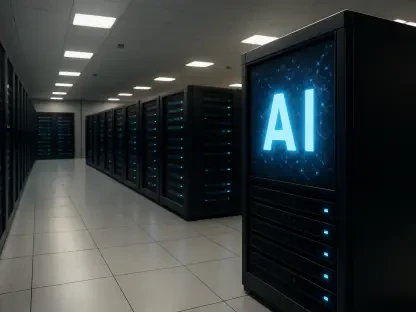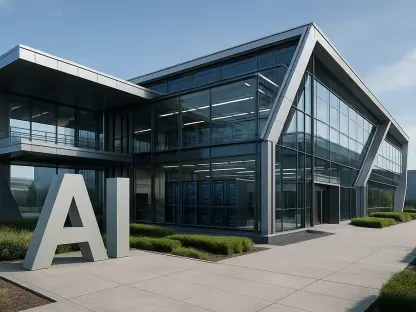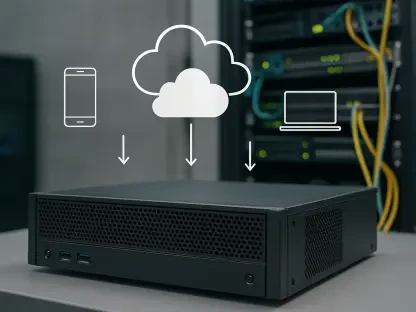In an era where digital transformation dictates the pace of business success, artificial intelligence (AI) stands as a game-changer for enterprise computing, fundamentally altering how organizations manage their technological infrastructure. The days of relying solely on centralized cloud systems for processing power are fading as AI introduces more dynamic and flexible approaches to workload management. This evolution is not just a trend but a necessity, driven by the need for faster response times, enhanced security, and cost-effective solutions in an increasingly data-driven world. Hybrid models, which integrate on-device, edge, and cloud computing, are emerging as the cornerstone of this shift, offering a balanced framework that addresses diverse operational demands. As enterprises grapple with the complexities of adopting AI at scale, understanding these hybrid architectures becomes essential for maintaining a competitive edge. This article explores the profound impact of AI on enterprise computing, delving into the mechanisms and strategies behind this transformative wave.
Evolving Beyond Centralized Systems
The traditional reliance on centralized cloud environments for AI processing, such as model training and inference, has long been the norm due to the immense computational resources these systems provide. However, this approach often results in significant challenges, including high latency and substantial costs associated with data transfer over long distances. A noticeable shift toward distributed AI processing is underway, where computation is brought closer to the data source, minimizing delays and reducing dependency on distant cloud servers. This transition is fueled by the growing demand for real-time decision-making in applications ranging from industrial automation to customer service chatbots. By processing data locally or at nearby edge points, enterprises can achieve faster results, which is critical for time-sensitive operations. This move away from a cloud-only mindset reflects a broader rethinking of how AI workloads should be managed to optimize both performance and resource allocation in a rapidly changing technological landscape.
Another dimension of this evolution lies in the strategic redistribution of AI tasks across various environments to suit specific needs. Distributed systems allow for routine, latency-sensitive tasks to be handled on-device or at the edge, while more complex computations, such as training large-scale models, are reserved for the cloud’s vast capabilities. This approach not only alleviates the burden on centralized systems but also cuts down on bandwidth usage, addressing a key pain point for businesses with massive data flows. Moreover, distributing workloads in this manner can enhance system resilience, as it reduces the risk of bottlenecks or failures tied to a single point of processing. As enterprises adopt these distributed models, they are finding that the flexibility to adapt to varying workload demands is a significant advantage, paving the way for more robust and responsive IT infrastructures that can keep pace with the dynamic nature of AI applications.
Hardware Innovations Driving AI Progress
Specialized hardware tailored for AI workloads has become a pivotal force in enabling the shift toward localized processing, marking a departure from generic computing solutions. Technologies such as Nvidia’s application-specific integrated circuits (ASICs) and neural processing units (NPUs) integrated into AI-enabled devices are at the forefront of this change, offering optimized performance for tasks like real-time inference. These advancements allow devices to handle complex AI operations directly, reducing the need to constantly communicate with remote cloud servers. This capability is particularly transformative for industries requiring immediate data processing, such as autonomous vehicles or smart surveillance systems, where even a millisecond of delay can have significant consequences. The rise of such hardware underscores a broader industry trend toward designing tools that meet the unique demands of AI, fundamentally altering the enterprise computing paradigm.
Beyond immediate performance gains, the development of specialized hardware also signals a long-term investment in making AI more accessible and efficient at the device level. By embedding powerful processing units into everyday business tools, from laptops to IoT devices, companies can execute sophisticated algorithms without the overhead of cloud dependency. This not only lowers operational costs but also opens up new possibilities for deploying AI in environments with limited connectivity, such as remote industrial sites. However, while these innovations are impressive, they are not without constraints, as on-device hardware often struggles with power consumption and thermal management, limiting the scope of tasks it can handle independently. Despite these hurdles, the continuous refinement of AI-specific hardware is set to play a central role in shaping how enterprises balance local and remote computing resources, ensuring that technology evolves in step with practical business needs.
Advantages and Obstacles of Blended Architectures
Hybrid AI architectures, which combine on-device, edge, and cloud computing, present a compelling solution by leveraging the strengths of each environment to address enterprise needs effectively. One of the primary benefits is scalability, allowing businesses to dynamically allocate workloads based on urgency and resource availability, ensuring optimal performance across diverse applications. Additionally, these models bolster security by processing sensitive data closer to its source, thereby reducing the risks associated with transmitting information over long distances—a critical factor for sectors like healthcare and finance that face stringent regulatory requirements. This blended approach also offers cost efficiencies by minimizing unnecessary data transfers while still harnessing the cloud for intensive computations, striking a balance that many organizations find indispensable in managing their AI initiatives.
Yet, the adoption of hybrid models is not without its challenges, as local processing on edge devices often encounters significant limitations that can hinder overall effectiveness. Constraints such as limited computational power, energy demands, and physical size restrictions mean that on-device systems cannot fully replace cloud infrastructure, especially for tasks requiring extensive resources like training generative AI models. These limitations necessitate a continued reliance on centralized systems for certain workloads, creating a complex balancing act for IT teams tasked with optimizing performance. Furthermore, integrating disparate systems into a cohesive hybrid framework can introduce compatibility issues and require substantial upfront investment in infrastructure upgrades. Despite these obstacles, the hybrid model remains a preferred strategy for many enterprises, as it provides the flexibility needed to navigate the intricate demands of modern AI deployment while addressing both operational and security concerns.
Navigating Workload Allocation Strategies
Determining the optimal placement of AI workloads is a critical decision for enterprises, involving a careful evaluation of multiple factors to ensure efficiency and compliance with organizational goals. Latency requirements often dictate that time-critical tasks, such as real-time analytics in retail or manufacturing, are processed locally or at near-edge locations to minimize delays that could disrupt operations. Simultaneously, data privacy concerns and regulatory mandates may compel businesses to keep sensitive information within controlled, on-site environments rather than risk exposure during cloud transmission. Cost considerations also play a pivotal role, as constant reliance on cloud resources for all tasks can inflate expenses, pushing companies to adopt a more measured approach that prioritizes local processing where feasible. Crafting a strategy that harmonizes these elements is essential for maximizing the benefits of AI technologies.
A flexible architecture that seamlessly integrates on-device, near-edge, and cloud computing emerges as a practical solution to these allocation challenges, offering a tailored fit for diverse workload profiles. Near-edge computing, in particular, serves as a vital intermediary, reducing the volume of data that must travel to distant servers while enhancing responsiveness for applications that demand quick turnarounds, such as IoT-driven smart grids. This intermediary layer helps alleviate network congestion and lowers associated costs, making it an attractive option for enterprises with geographically dispersed operations. However, achieving this integration requires meticulous planning to ensure that systems communicate effectively and that workload distribution aligns with strategic priorities. As businesses refine their approaches, the ability to adapt workload placement dynamically will likely become a defining factor in maintaining operational agility and competitive advantage in an AI-centric market.
Shaping Tomorrow’s Enterprise Landscape
The trajectory of AI in enterprise computing points toward a sustained reliance on hybrid models, with no single processing paradigm expected to dominate in the foreseeable future due to the diverse nature of business requirements. As emerging technologies continue to redefine what is possible, organizations must remain vigilant, adapting their infrastructure to accommodate new types of workloads and performance expectations. This adaptability is particularly crucial as AI applications grow in complexity, demanding ever-greater computational resources and innovative approaches to data handling. Projections indicate that by 2027, a significant majority of enterprises will deploy AI inference at the edge, highlighting the accelerating trend toward decentralization and the need for robust, mixed-environment strategies to support this shift. Staying ahead in this landscape requires a commitment to continuous evaluation and adjustment of computing frameworks.
Reflecting on the journey so far, it’s clear that the integration of on-device, edge, and cloud processing has already begun to redefine enterprise computing, offering a glimpse into a more balanced and efficient future. The strides made in hardware innovation and distributed architectures have laid a strong foundation for tackling the dual challenges of performance and security. Looking back, the emphasis on strategic workload placement has proven to be a linchpin for many organizations striving to optimize their AI deployments. Moving forward, the focus should be on investing in interoperable systems that can seamlessly bridge different computing environments, ensuring that businesses can scale operations without friction. Additionally, fostering partnerships with technology providers to access cutting-edge tools and insights will be vital for navigating the evolving demands of AI-driven enterprise computing, setting the stage for sustained growth and resilience.









